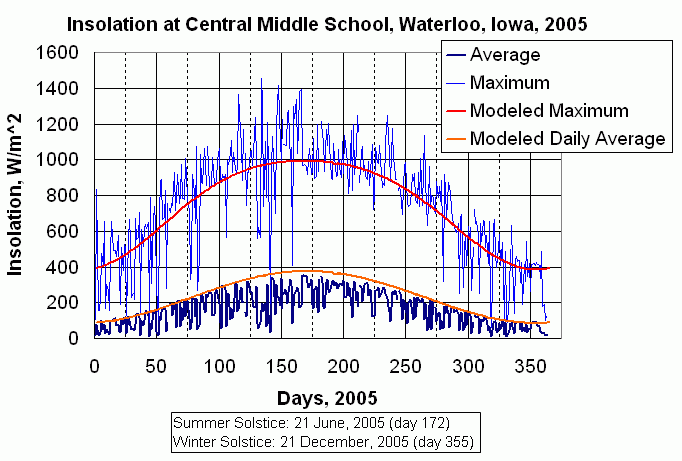
David Brooks, March, 2006
The availability of reliable insolation measurements from Waterloo, Iowa, as described elsewhere on this site, provides an opportunity to examine the performance of a very simple "clear sky" insolation model [Duchon and O'Malley, 1999; Meeus, 1991]. Duchon and O'Malley's model assigns values to atmospheric transmission terms, dimensionless values between 0 and 1, for Rayleigh (molecular) scattering, gaseous absorption, aerosol scattering and absorption, and water vapor absorption. Each of these transmission factors depends on assumed average "broadband" atmospheric properties and the elevation angle of the sun.
The figure shows daily maximum (blue) and daily average (dark blue) insolation values at Waterloo Central Middle School for 2005, and the calculated daily maximum (red) and daily average (orange) values.
 |
Note that measured daily maximum values are not a good indicator of daily insolation. Of course, overall insolation is reduced under cloudy conditions. However, sunlight reflected from sides of clouds can momentarily increase insolation seen on the ground. The data logger used at Waterloo CMS records instantaneous values at one-minute intervals, without any averaging. As a result, the day-to-day "noise" in the maximum insolation can also be seen one a much shorter minute-to-minute time scale in the data for individual days.
The daily average values are a better indicator of changing conditions during the year. The Duchon and O'Malley model performs well during winter months, but overestimates insolation during the summer. This is not an unexpected result because of the initial assumptions made in the model. For these calculations, total precipitable water vapor is assumed to be 1.42 cm H2O, the value used in U.S. Standard Atmosphere models. This is a low value for summers in temperate climates. The aerosol transmission factor is assumed to be 0.935, which is also low for summers in temperate climates. Assuming that the same patterns emerge in other years, these data could be used to generate an empirical model to improve overall performance of the Duchon and O'Malley model for this location, and perhaps for other locations having similar climates.
References:
Duchon and O'Malley. Journal of Applied Meteorology, 38, pp 132-141, 1999.
Meeus, Jean, Astronomical Algorithms. Willmann-Bell, Inc., Richmond, VA, 1991.